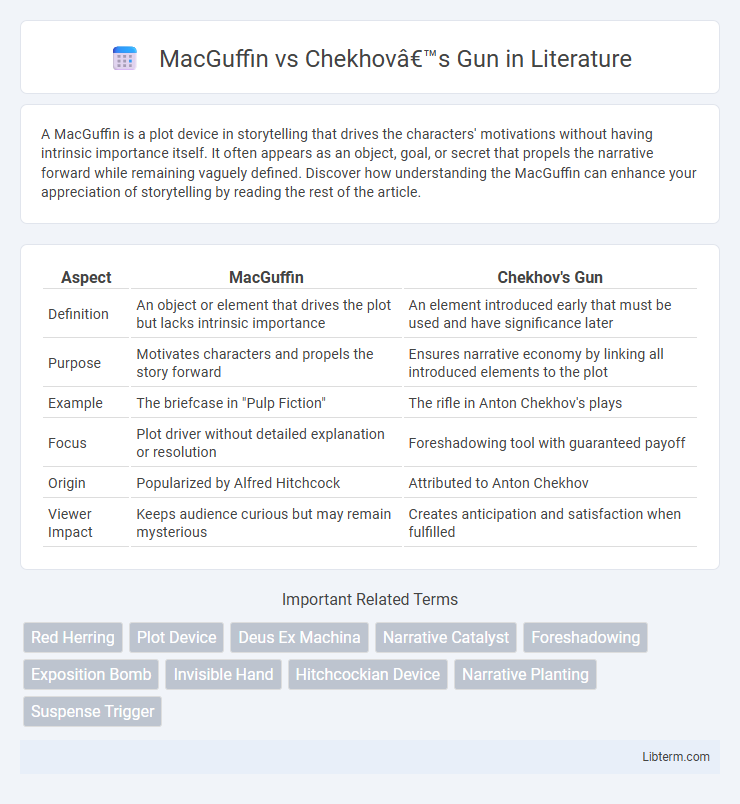A MacGuffin is a plot device in storytelling that drives the characters' motivations without having intrinsic importance itself. It often appears as an object, goal, or secret that propels the narrative forward while remaining vaguely defined. Discover how understanding the MacGuffin can enhance your appreciation of storytelling by reading the rest of the article.
Table of Comparison
| Aspect | MacGuffin | Chekhov's Gun |
|---|---|---|
| Definition | An object or element that drives the plot but lacks intrinsic importance | An element introduced early that must be used and have significance later |
| Purpose | Motivates characters and propels the story forward | Ensures narrative economy by linking all introduced elements to the plot |
| Example | The briefcase in "Pulp Fiction" | The rifle in Anton Chekhov's plays |
| Focus | Plot driver without detailed explanation or resolution | Foreshadowing tool with guaranteed payoff |
| Origin | Popularized by Alfred Hitchcock | Attributed to Anton Chekhov |
| Viewer Impact | Keeps audience curious but may remain mysterious | Creates anticipation and satisfaction when fulfilled |
Introduction to Narrative Devices
MacGuffin and Chekhov's Gun are essential narrative devices that drive plot development and audience engagement. A MacGuffin is an object or goal with little intrinsic importance but motivates characters' actions, whereas Chekhov's Gun demands that every element introduced must have a significant purpose in the story. Understanding these concepts enhances storytelling efficiency by creating meaningful plot points and avoiding narrative clutter.
Defining the MacGuffin
A MacGuffin is a plot device or object that drives the story's action but lacks intrinsic importance or detailed explanation within the narrative. It serves primarily to motivate characters and advance the plot, often remaining undefined or mysterious throughout the story. Unlike Chekhov's Gun, which must have a clear and purposeful presence, the MacGuffin functions as a narrative catalyst without direct resolution.
Understanding Chekhov’s Gun
Chekhov's Gun is a dramatic principle that emphasizes the importance of every element introduced in a story having a clear purpose, especially objects that must become relevant by the narrative's climax. Unlike a MacGuffin, which is a plot device that drives the story but lacks intrinsic significance, Chekhov's Gun demands narrative economy, ensuring each prop or detail directly impacts character actions or plot developments. This principle sharpens storytelling by eliminating superfluous elements and heightening audience engagement through meaningful foreshadowing.
Origins and Historical Context
MacGuffin, popularized by Alfred Hitchcock in the 1930s and 1940s, refers to an object or goal driving the plot but often lacking intrinsic importance. Chekhov's Gun, originating from playwright Anton Chekhov in the late 19th century, emphasizes narrative economy by introducing elements that must be relevant and used later in the story. Both concepts shaped storytelling by influencing how writers balance plot motivation with cohesive and purposeful detail.
Key Differences Between MacGuffin and Chekhov’s Gun
MacGuffin and Chekhov's Gun serve distinct narrative purposes; a MacGuffin is an object or goal that drives the plot but lacks intrinsic significance, while Chekhov's Gun is a seemingly minor detail introduced early that gains critical importance later. The MacGuffin motivates characters' actions without necessarily being explained, whereas Chekhov's Gun demands narrative payoff, ensuring each element introduced is essential to the story's resolution. Understanding these differences clarifies their use in storytelling, with MacGuffins manipulating plot momentum and Chekhov's Guns ensuring tight narrative economy.
Classic Examples in Film and Literature
MacGuffin and Chekhov's Gun serve distinct narrative roles, often exemplified in classic works: Alfred Hitchcock's "North by Northwest" uses a MacGuffin with the mysterious microfilm driving the plot, while Anton Chekhov's principle appears in "The Seagull" through the poignant significance of a rifle introduced early but pivotal later. In literature, the One Ring in Tolkien's "The Lord of the Rings" acts as a MacGuffin motivating characters, contrasting with Chekhov's Gun found in Shakespeare's "Macbeth" where the prophecy and weapons introduced foreshadow key outcomes. These storytelling techniques enhance plot engagement by focusing on objects that respectively catalyze the narrative or guarantee consequence when invoked.
The Role in Story Structure
A MacGuffin drives the plot without intrinsic value, often motivating characters but remaining unexplained, serving as a catalyst in story structure. Chekhov's Gun demands that every introduced element must be essential and has a direct payoff, ensuring narrative economy and coherence. Together, these devices shape story progression by balancing mystery and narrative precision.
Impact on Audience Engagement
MacGuffins drive audience engagement by creating suspense and curiosity around an object or goal whose intrinsic value may be minimal, pushing characters into action and maintaining plot momentum. Chekhov's Gun enhances engagement through narrative economy, ensuring every introduced element has significant payoff which builds anticipation and satisfaction when it is revealed or utilized. Both techniques manipulate expectations but differ in their impact by either fostering mystery or guaranteeing narrative coherence and resolution.
Common Misconceptions
MacGuffins are often misunderstood as mere plot devices lacking narrative weight, but they serve to drive character motivation and thematic exploration, unlike Chekhov's Gun which demands narrative necessity and payoff. A common misconception is that Chekhov's Gun must be a literal object, while it can also be symbolic or thematic elements introduced early that become crucial later. Both concepts emphasize importance in storytelling, yet MacGuffins maintain ambiguity and multiple interpretations, contrasting with Chekhov's Gun's requirement for clear, purposeful relevance.
Choosing the Right Device for Your Story
Choosing between a MacGuffin and Chekhov's Gun depends on the narrative purpose and thematic focus of your story. A MacGuffin drives the plot by motivating characters despite its intrinsic value being irrelevant, while Chekhov's Gun ensures every element introduced has a crucial payoff, enhancing story cohesion and foreshadowing. Selecting the right device hinges on whether you need a plot catalyst that sparks action or a tightly woven element that contributes directly to the resolution.
MacGuffin Infographic

 libterm.com
libterm.com